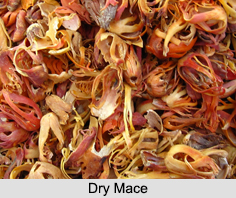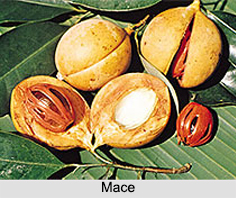 The Indian spice mace belongs to the Myristicaceae and scientifically known as Myristica Fragrans. It is a strong aromatic, resinous spice that is warm in taste. The mace spice is dry with an outer aril that firmly envelops around the nutmeg kernel. Nutmeg and mace indeed are two separate spice products of the same nutmeg fruit. However, mace characteristically has higher concentration of certain essential oils and features refined yet intense aroma than nutmeg. For the same reasons, it commands special place in the kitchen spice box. In Hindi mace is known as Javitri, Javinthri, Jaypatri.
The Indian spice mace belongs to the Myristicaceae and scientifically known as Myristica Fragrans. It is a strong aromatic, resinous spice that is warm in taste. The mace spice is dry with an outer aril that firmly envelops around the nutmeg kernel. Nutmeg and mace indeed are two separate spice products of the same nutmeg fruit. However, mace characteristically has higher concentration of certain essential oils and features refined yet intense aroma than nutmeg. For the same reasons, it commands special place in the kitchen spice box. In Hindi mace is known as Javitri, Javinthri, Jaypatri.
Origin of Mace
Mace is originally grown from the nutmeg tree in Molucca Islands in Indonesia. The Portuguese controlled the Mace trade until they were driven out by the Dutch in 1602.
Botany of Mace
The mace plant grows into a tropical evergreen tree of up to 30 ft tall. The same tree also produces the better known nutmeg spice. The trees first produce fruit in about 7 years and then yield approximately 10 pounds of dried shelled nutmeg and 1.5 pounds of dried mace per tree. There are both male and female trees and are planted in a ratio of about one male tree for every 10 female trees. At low concentrations, both nutmeg and mace possess a sweet, warm and highly spicy flavour with mace being slightly stronger. Ground nutmeg is tan in colour, while mace has an orange hue.
The nutmeg tree is evergreen, with oblong egg-shaped leaves and small, bell-like light yellow flowers that give off a distinct aroma when in bloom. The fruit is light yellow with red and green markings, resembling an apricot or a large plum. As the fruit matures, the outer fleshy covering bursts to reveal the seed known commercially as nutmeg. The seed is covered with red membranes called an aril, the mace portion of the nutmeg. The nut is then dried for up to 2 months until the inner nut rattles inside the shell. It is then shelled to reveal the valuable egg-shaped nutmeat which is the edible nutmeg. Second-rate nuts are pressed for the oil, which is used in perfumes and in the food industry.
 Health benefits of Mace
Health benefits of Mace
Mace contains some of the anti-oxidant compounds essential oils, minerals, and vitamins.
Mace helps in keeping the digestive system healthy and successfully relieves bloating, constipation and gas related problems.
The active principles in this spice have many therapeutic applications in many traditional medicines as anti-fungal, anti-depressant, aphrodisiac, digestive, and carminative functions.
Mace arils contain more vitamin-A, vitamin-C, calcium, copper, iron and magnesium than nutmeg.
Mace also encourages appetite and boosts blood circulation, which in turn keeps skin and hair healthy.
Medicinal uses of Mace
Mace extraction has also been in use as traditional medicines for treatment of illnesses related to the nervous and digestive systems.
Nutmeg oil and mace-oil has been used in dentistry for toothac he relief.
The oil from mace is also used as a local massage to reduce muscular pain and rheumatic pain of joints.
Freshly prepared mace-decoction with honey has been employed to get relief from nausea, gastritis, and indigestion ailments.
Studies show mace has anticancer, antifungal, antibacterial, anti-inflammatory, and larvicidal properties.
Mace is also used for treating cancer, kidney disease, and insomnia, increasing menstrual flow.
Selection and storage of Mace
In the stores, one can buy whole mace, straight slivers known as "Mace Blades", or ground powder packed inside air-sealed containers. The more the mace gets drier it turns out to be more orange in colour that resembles its guarantee of high quality. The mace is also found in creamy and brown varieties. Look for whole mace or its blades instead of powder since powdered mace shall lose its flavour rather quickly because of evaporation of essential oils.
Once at home, store the whole mace spice and blades in an airtight container and place it in cool, dark and dry place, where it can stay for several months. Ground mace, however, should be stored in well-sealed packs and used as quickly as possible. The Nutmeg tree is important for two spices derived from the fruit, Nutmeg and Mace.
Culinary uses of Mace
Mace has a versatile flavour that can be used in various cooking preparations. Both nutmeg as well as mace spice are employed widely in cooking recipes. The mace is a highly nutritional product that contains protein and fibre. Although, mace and nutmegs can be used interchangeably, mace has a pleasant yet more intense flavour than nutmeg, and gives light saffron colour to the dishes it is added to. Mace blades should be fished out before serving. Instead, they may seep in hot water and the extraction may be directly added to the recipes.
In the Indian subcontinent where it is popular as javitri, mace is found in an array of sweet and savoury recipes. It gives sweet, warm and pleasant flavour, especially to the bakery foods like pastries, donuts, cake, etc.
Mace also employed as one of the common ingredients in the spice mix, particularly in Indian "garam masala" powder.
Its freshly ground powder is added to meat stews, bean stews, sauces, and soups.
Safety profile of Mace
Consumption of nutmeg as well as mace spice in large doses may cause lack of concentration, sweating, palpitations, body pain and in severe case; hallucination and delirium.
In very small doses, it may be used safely in pregnancy and lactation. High dose might cause a miscarriage due to the increase in menstrual flow.




















